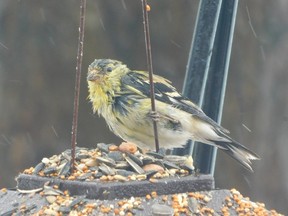This week's collection of Sightings

Article content
Sharon’s very wet male American goldfinch is in the middle of his spring molt from drab olive-brown to bright yellow body and black wings and tail. Birds like the goldfinch molt twice each year – a complete molt of body and flight (wing and tail) feathers in early fall plus a spring molt of body feathers only. We can see the bright yellow feathers of spring on this male’s body. However, this bird looks to be unusually wet and I hope its drenched appearance isn’t an indication that it’s sick. If it continues to look bedraggled and appears listless after the weather clears I would take my feeders in for several weeks and give them a good cleaning, first a good bath in warm soapy water and then after rinsing well, a soaking in a 10 per cent water/bleach solution (10 per cent bleach) to hopefully kill any bacteria that might be present if the bird is infected with something. Jim

We usually expect only birds at our feeders, but suet is attractive to mammals too. Foxes tend to be more active at night, but sometimes they will hunt during the day, especially during late winter or early spring when food can be harder to get. Females should be giving birth to kits about now and once they are weaned there will be an increased need for meat and even more hunting effort required. Jim

Mackenzie is right, the European starling is an eye-catching bird. As many know, the name “starling” comes from the white tips on the body feathers that are present in the plumage of adults from fall to early spring. By late April most tips will be worn off and the starling becomes glossy black with hues of purple, green and violet for the spring breeding season. Fresh spangled plumage will come with the next moult in late summer or early fall. Jim

John’s image shows the colours of the common grackle in the background very nicely while the male red-winged blackbird in the foreground shows the frontal yellow edge of his distinctive red shoulder patch. Males of both species usually return first from the south, with females flying back a week or two later. In the case of the grackle, the female is a bit smaller overall than the male and black, but with less iridescence. By contrast, female red-winged blackbirds is a mixture of brown and black and is striped lengthwise with paler streaking, making her look more sparrow-like. Jim

Peanuts in the shell are indeed a special attractant for blue jays and squirrels at a feeder. My experience is that they’ll continue to carry off and hide the peanuts for as long as they’re made available to them, so I now put just a limited number of unshelled peanuts out each day. Otherwise we’d be eaten out of house and home before very long. Jim

Heather submitted two photos and I chose this one to give us a dorsal view of this song sparrow. The song sparrow is the most widespread and abundant sparrow we have in N.B., so it serves as a useful “default” sparrow to compare with all the others. This is a “streaked sparrow” meaning it has brown streaking on its under parts. Some other sparrows are clear below. The song sparrow’s streaking is wide and coarse, not fine streaking. Looking at the grey face we see it has a wide brown streak from the eye backward, a creamy pale stripe along the jaw-line and at each side of the throat a conspicuous patch of darker brown. The tail is proportionately longer than most of our other sparrows and has a slight rusty tinge to its upper surface. The back and folded wings are a mixture of various medium and dark brown feathers. Another feature of the familiar song sparrow is that when it flies a short distance it usually flies close to the ground and it always “pumps” its rather long tail up and down, distinctively, as it goes. Jim

Darlene’s photo shows a common grackle on the upper left along with a number of European starlings. Although these birds are together now at the feeder, each species will soon split off to form breeding pairs and begin nesting by early May. Although they may still make occasional feeder visits, their diet will turn more to insects during the nesting season as insects should be numerous and provide better nutrition for growing youngsters. Jim

A heated birdbath in winter is a big attractant for resident birds like mourning doves, chickadees and cardinals and apparently appreciated. Some baths have built-in electric heaters, but you can also purchase coil heaters with thermostats that can be placed in a bowl or other vessel partly filled with water and they work just fine. The thermostat ensures the water doesn’t freeze, but also that the heater doesn’t run longer than necessary during cold weather. Jim
JIM WILSON is the chair of the New Brunswick Bird Records Committee. Send your Sightings of live animals and birds by email to tjsightings@postmedia.com. Please indicate your full name and the community where you live. Due to space constraints, we are not able to publish all the submissions we receive.












Postmedia is committed to maintaining a lively but civil forum for discussion. Please keep comments relevant and respectful. Comments may take up to an hour to appear on the site. You will receive an email if there is a reply to your comment, an update to a thread you follow or if a user you follow comments. Visit our Community Guidelines for more information.